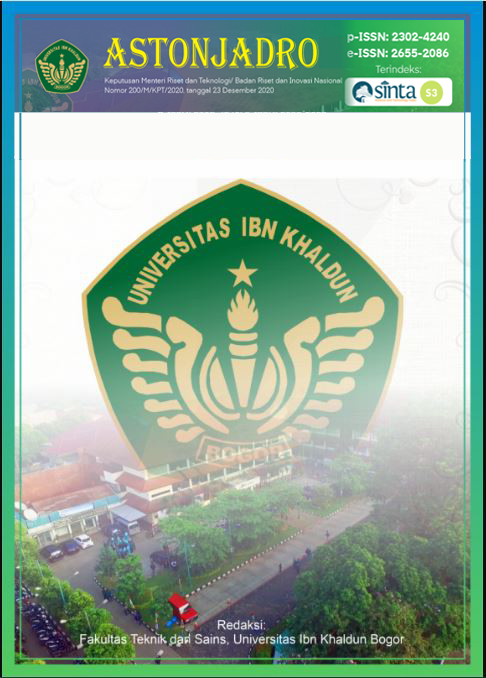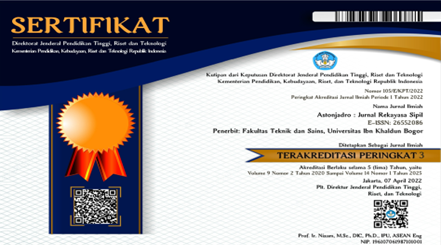Review of Cultural Preservation Theory in Cultural Heritage Sustainability Case Study of Peliatan Ubud Palace
DOI:
https://doi.org/10.32832/astonjadro.v14i1.17183Keywords:
cultural preservation theory; cultural heritage sustainability; peliatan palace.Abstract
This research aims to review cultural preservation theory in the context of cultural heritage sustainability with a case study of Peliatan Palace in Ubud, Bali. The intended conservation theory is a theory by Sendjaja which consists of Culture Experience and Culture Knowledge. Peliatan Palace is one of the cultural heritage sites in Bali which is still preserved today and has high historical and cultural value. This research uses qualitative methods with a case study approach to reveal how cultural preservation is carried out at Peliatan Palace and the factors that influence the sustainability of this cultural heritage. The research results show that cultural preservation at Peliatan Palace is carried out through various efforts, including maintaining the traditional architecture of the castle, carrying out traditional ceremonies, and active involvement of local communities in cultural activities. Internal factors such as the commitment of the Palace family and external factors such as government support and tourism play an important role in maintaining cultural preservation at Peliatan Palace. Apart from that, adapting to current developments without eliminating traditional values is also the key to maintaining the cultural heritage of this castle. This research concludes that cultural preservation at Peliatan Palace is not only important for maintaining local cultural identity but also having a positive impact on community welfare and the promotion of Balinese culture on the international stage. Sustainable and adaptive preservation efforts to changing times are needed to ensure that future generations can enjoy this cultural heritage.
References
Ardika, I. W. (2015). Warisan Budaya Perspektif Masa Kini. Udayana University Press.
Ardhana, I. K., & Setiawan, I. K. (2014). Raja Udayana Warmadewa. Larasan.
Astiti, T. I. P. (2010). Desa Adat Menggugat Dan Digugat. Udayana University Press.
Braun, V., & Clarke, V. (2006). Using Thematic Analysis in Psychology. Qualitative research in Psychology, 3(2), 77-101.
Covarrubias, M. (2013). Island of Bali. Periplus Editions.
Geriya, I. W. (2013). Pola Partisipatoris Dalam Pembangunan Pariwisata Budaya di Bali. Upada Sastra.
Hitchcock, M., & Putra, I. N. D. (2007). Tourism, Development And Terrorism In Bali. Ashgate Publishing.
MacRae, G. S. (2012). Ubud: Becoming A Tourist Town In Bali. In T. Winter, P. Teo, & T. C. Chang (Eds.), Asia on tour: Exploring the rise of Asian tourism (pp. 161-176). Routledge.
Picard, M. (1996). Bali: Cultural Tourism And Touristic Culture. Archipelago Press.
Pitana, I. G. (2010). Tri Hita Karana – The Local Wisdom Of The Balinese In Managing Development. In R. Conrady & M. Buck (Eds.), Trends And Issues In Global Tourism 2010 (pp. 139-150). Springer.
Putra, I. N. D. (2014). Empat Srikandi: Perempuan Berbakat Bali Menembus Dunia Global. Pustaka Larasan.
Reuter, T. A. (2002). Custodians Of The Sacred Mountains: Culture And Society In The Highlands Of Bali. University of Hawaii Press.
Ruastiti, N. M. (2010). Seni Pertunjukan Bali Dalam Kemasan Pariwisata. Bali Mangsi Press.
Sendjaja, S. Djuarsa. (1994). Teori Komunikasi. Jakarta: Universitas Terbuka
Suartika, G. A. M. (2010). Morphing Bali: The State, Planning, And Culture. Lambert Academic Publishing.
Sutaba, I. M. (2014). Sejarah Bali: Dari Prasejarah Hingga Modern. Udayana University Press.
UNESCO. (1972). The World Heritage Convention. Diakses melalui https://whc.unesco.org/ tanggal 29 Juni 2024
Vickers, A. (2012). Bali: A Paradise Created. Tuttle Publishing.
Yin, Robert K, Studi Kasus Desain & Metode, Rajawali Pers, Jakarta, 2014.
Downloads
Published
How to Cite
Issue
Section
License
Copyright (c) 2025 ASTONJADRO

This work is licensed under a Creative Commons Attribution-ShareAlike 4.0 International License.
Paper submitted to ASTONJADRO is the sole property of the Astonjadro Journal. Unless the author withdraws the paper because he does not want to be published in this journal. The publication rights are in the journal Astonjadro.ASTONJADRO
LICENSE
This work is licensed under a Creative Commons Attribution-ShareAlike 4.0 International License.
Based on a work at http://ejournal.uika-bogor.ac.id/index.php/ASTONJADRO













